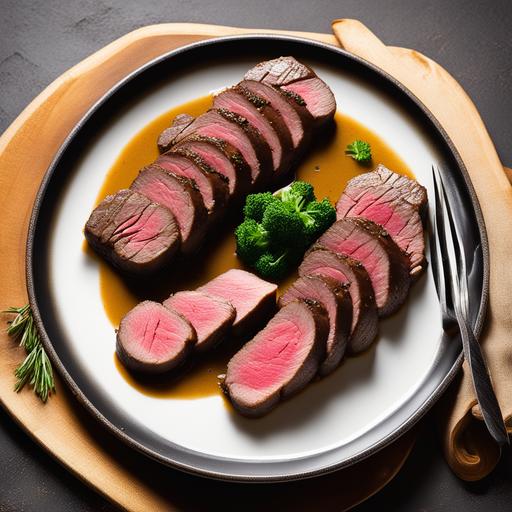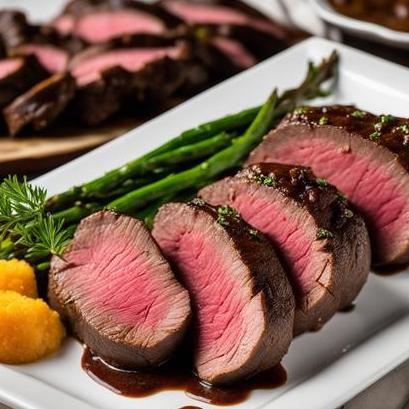Venison Tenderloin: The Perfect Dish For Air Fryer Enthusiasts

Are you a fan of succulent, tender venison? Do you love using your air fryer to create delicious and healthy meals? If so, then this comprehensive guide is just for you. In this article, we will take a deep dive into the world of venison tenderloin, covering various aspects ranging from food science to culinary details, selection, cleaning, preparation, tips, variations, doneness checks, and an irresistible recipe. So, let’s get started!
The Food Science Behind Venison Tenderloin
Venison tenderloin, also known as deer fillet, comes from the muscle that runs alongside the spine of the deer. This cut is incredibly tender and boasts a rich flavor, making it highly sought after by venison lovers. It’s important to understand the food science behind this cut to ensure perfect cooking results.
The tenderloin muscle is composed of long, lean fibers that are relatively low in connective tissue. This attribute gives venison tenderloin its tenderness but also means that it’s prone to drying out if overcooked. Hence, it is crucial to handle this delicate cut carefully and cook it to perfection.
Culinary Details: Selecting the Best Venison Tenderloin
When it comes to selecting venison tenderloin, freshness and quality are key factors to consider. Look for meat that is deep red in color, indicating that it is fresh and hasn’t been stored for an extended period. Avoid cuts that appear grayish or have a strong smell, as these are signs of spoilage.
If you have the opportunity, try to source venison tenderloin from a reputable butcher or a trusted game processor. They can guide you in choosing the best cut and may even offer different options, such as wild or farm-raised venison. Keep in mind that wild venison tends to have a stronger flavor compared to its farm-raised counterpart. Both options, however, can yield fantastic results in your air fryer.
Cleaning Venison Tenderloin: Ensuring Optimal Flavor and Safety

Proper cleaning of venison tenderloin is essential to remove any impurities and ensure food safety. Follow these steps to clean your cut effectively:
- Start by rinsing the tenderloin under cold water, gently rubbing the surface to eliminate any surface debris.
- Pat the meat dry with paper towels to remove excess moisture.
- Inspect the tenderloin for any remaining silverskin, a thin layer of connective tissue. If present, use a sharp knife to remove it.
- Trim any visible fat or membranes, as excessive fat can lead to flare-ups in the air fryer.
Remember, maintaining cleanliness throughout the cooking process is critical to avoid cross-contamination. Wash your hands, utensils, and cutting board after handling raw venison to prevent the spread of bacteria.
Time to Prep: Marinating and Seasoning Tips

Marinating and seasoning venison tenderloin properly can enhance its natural flavors and ensure juiciness. Here are some tips to help you achieve maximum flavor:
Marinating Tips:
- Consider marinating the tenderloin for a few hours or overnight to tenderize the meat. A simple marinade can consist of olive oil, garlic, herbs, and a touch of acidity from lemon or vinegar. The acid helps break down the muscle fibers, resulting in a more tender cut.
Seasoning Tips:
- To enhance the natural flavors of venison, opt for seasonings that complement its rich taste. A classic combination includes salt, black pepper, and dried rosemary. However, feel free to experiment with your favorite herbs and spices.
Remember that seasoning is a personal choice, so adjust the amount of salt, pepper, and other spices based on your preferences. Just be cautious not to overpower the delicate flavor of the venison.
The Air Fryer Technique: Achieving the Perfect Cook

Now that we’ve covered the groundwork for venison tenderloin, let’s delve into the air fryer technique. Follow these steps to achieve a perfectly cooked, tender venison masterpiece:
- Preheat your air fryer to 400°F (200°C). This temperature is ideal for achieving a balance between a nicely seared exterior and a tender, medium-rare interior.
- Remove the marinated venison tenderloin from the refrigerator and allow it to sit at room temperature for 15-20 minutes.
- Spray the air fryer basket with cooking oil to prevent sticking.
- Place the tenderloin in the air fryer basket, ensuring it’s not overcrowded and has enough space for proper air circulation.
- Cook the venison tenderloin for approximately 10-12 minutes, flipping it halfway through the cooking process. This timing can vary based on your air fryer’s model and wattage, as well as the thickness of the tenderloin. Aim for an internal temperature of 135°F (57°C), which will result in a medium-rare doneness. Use a meat thermometer to ensure accuracy.
- Once the desired internal temperature is reached, remove the tenderloin from the air fryer and let it rest for 5-10 minutes. This step is crucial as it allows the juices to redistribute and ensures a juicy, tender final result.
Doneness Checks: Ensuring Perfect Cooking Results

Determining the doneness of venison tenderloin with accuracy is vital to achieving the desired level of juiciness. Here are three primary methods for checking the doneness:
- Meat Thermometer: Use a reliable, instant-read meat thermometer to measure the internal temperature. As previously mentioned, a range of 135°F (57°C) for medium-rare is recommended. For a more well-done tenderloin, aim for 145°F (63°C) for medium or 160°F (71°C) for well-done.
- Finger Test: This method involves comparing the resistance of the cooked tenderloin to different parts of your hand. Gently press the meat with your index finger and compare the firmness to the firmness of your hand’s muscles. A tenderloin cooked to medium-rare should feel similar to the fleshy part of your palm just below the thumb.
- Visual Check: Cut into the thickest part of the tenderloin with a sharp knife and observe the color. For medium-rare, the center should be pink or slightly red, transitioning to a grayish-brown color towards the edges.
Remember, practice makes perfect when it comes to determining the doneness of venison tenderloin. With experience, you’ll develop an intuitive sense for achieving the perfect cook.
Versatile Recipe Variations for Venison Tenderloin in the Air Fryer
Now that you’ve mastered the basics, let’s explore some exciting recipe variations to spice up your venison tenderloin:
1. Herb-Crusted Venison Tenderloin
-
Ingredients:
- 1 venison tenderloin
- 2 tablespoons olive oil
- 2 tablespoons fresh thyme, chopped
- 1 tablespoon fresh rosemary, chopped
- Salt and pepper to taste
-
Instructions:
- Follow the cleaning and seasoning steps mentioned earlier.
- Combine olive oil, thyme, rosemary, salt, and pepper in a bowl to create a paste.
- Rub the paste all over the tenderloin, ensuring it’s evenly coated.
- Follow the air fryer technique outlined previously, adjusting cooking times as needed.
- Let the tenderloin rest before slicing it into thin, succulent medallions.
2. Teriyaki-Glazed Venison Tenderloin
-
Ingredients:
- 1 venison tenderloin
- ½ cup teriyaki sauce
- 2 cloves garlic, minced
- 2 tablespoons honey
- 1 tablespoon sesame seeds (optional)
-
Instructions:
- Marinate the venison tenderloin in a mixture of teriyaki sauce, garlic, and honey for at least an hour or overnight.
- Preheat your air fryer and prepare the tenderloin following the air fryer technique provided.
- While the tenderloin cooks, transfer the remaining marinade to a small saucepan and bring it to a boil. Reduce the heat and simmer until slightly thickened.
- Brush the teriyaki glaze onto the cooked tenderloin, allowing it to caramelize for a minute in the air fryer.
- Sprinkle sesame seeds over the glazed tenderloin, adding a delightful crunch and nutty flavor.
Feel free to experiment with various herbs, spices, and marinades to create your own unique twist on venison tenderloin in the air fryer. The possibilities are endless!
Final Tips for a Successful Cooking Experience
To ensure a successful cooking experience and provide you with additional guidance, here are some extra tips to keep in mind:
- Thaw frozen venison tenderloin in the refrigerator for 24-48 hours before cooking. This gradual thawing prevents the meat from losing moisture.
- Keep the tenderloin covered while it rests, as this preserves the warmth and prevents excessive cooling.
- Serve venison tenderloin with accompanying sauces, such as a light pan sauce, cranberry relish, or even a red wine reduction, to elevate the flavors further.
- Pair your venison tenderloin with a side of roasted vegetables, mashed potatoes, or a fresh salad for a well-rounded meal.
Start Your Venison Tenderloin Adventure Today!
With this comprehensive guide, you’re well-equipped to embark on your venison tenderloin adventure in the air fryer. Remember to handle this delicate cut with care, experiment with flavors, and adjust cooking times based on your air fryer’s specifications. Enjoy the succulent, melt-in-your-mouth experience this exceptional dish has to offer. Happy cooking!
Sources
FAQS On Venison Tenderloin Air Fryer Recipe
What Is The Best Cooking Temperature For Venison Tenderloin In An Air Fryer?
The ideal cooking temperature for venison tenderloin in an air fryer is 400°F (200°C). This high heat will allow the meat to cook evenly and develop a crispy exterior while still retaining its natural tenderness.
How Long Should I Cook Venison Tenderloin In An Air Fryer?
The cooking time for venison tenderloin in an air fryer can vary depending on the thickness of the meat and personal preference for doneness. As a general guideline, it is recommended to cook the tenderloin for around 12-15 minutes for medium-rare, flipping halfway through the cooking time.
Should I Preheat The Air Fryer Before Cooking Venison Tenderloin?
Yes, it is important to preheat the air fryer before cooking venison tenderloin. Preheating ensures that the air fryer reaches the desired cooking temperature, allowing for more consistent and efficient cooking.
Can I Marinate Venison Tenderloin Before Air Frying?
Absolutely! Marinating the venison tenderloin before air frying can enhance its flavor and tenderness. You can use a simple marinade of olive oil, garlic, herbs, and spices to infuse the meat with delicious flavors. It is recommended to marinate the meat for at least 30 minutes, but overnight marination will yield even better results.
Do I Need To Oil The Venison Tenderloin Before Air Frying?
It is not necessary to oil the venison tenderloin before air frying, as the meat already contains a good amount of natural fats. However, if you prefer a slightly crispier texture, you can lightly brush the meat with oil or use a cooking spray to help achieve a golden brown crust.
Can I Use Frozen Venison Tenderloin In The Air Fryer?
Yes, you can cook frozen venison tenderloin in the air fryer, but it will require additional cooking time. It is recommended to thaw the meat thoroughly before cooking for more even and consistent results. If cooking from frozen, add an extra 5-7 minutes to the cooking time.
How Can I Ensure That My Venison Tenderloin Stays Juicy When Cooked In An Air Fryer?
To keep the venison tenderloin juicy when cooked in an air fryer, it is essential not to overcook the meat. Follow the recommended cooking time for your desired level of doneness, and always use a meat thermometer to check the internal temperature. For medium-rare, the internal temperature should reach around 135°F (57°C). Let the meat rest for a few minutes before slicing to allow the juices to redistribute.


